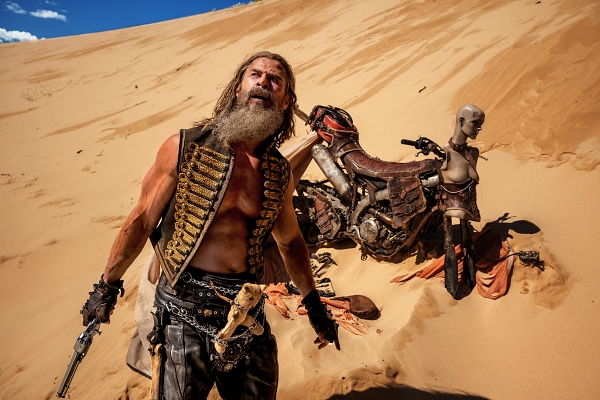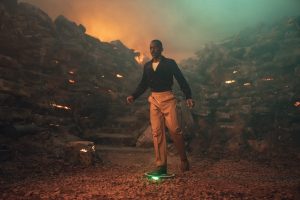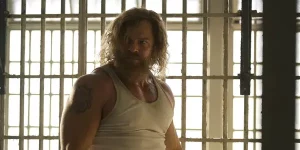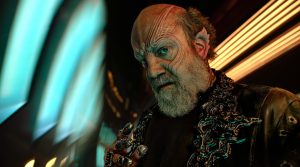
Prequelitis, for the purposes of this review, refers to a narrative condition often present in movie prequels, where the story is constrained by the need to align with an already established endpoint. This means that the destination and eventual fate of a character are predetermined in a sense, which can put unnatural constraints on the creative freedom of any film. The challenge of prequelitis is to craft a compelling journey that leads to a known outcome, maintaining tension and interest despite the audience’s keen awareness of where the story will ultimately lead. Some do this masterfully (Andor, Better Call Saul) while others get bogged down in plot machinations and narrative clutter (Solo: A Star Wars Story, The Hobbit Trilogy). Both usually involve filling in backstory, explaining character motivations, plenty of franchise Easter Eggs, and setting up plot points that will pay off within this journey and in future storylines, all while maintaining an aesthetic and tonal consistency with its original intellectual property.
This brings us to Furiosa: A Mad Max Saga. We first met Furiosa (as played by Charlize Theron) in director George Miller’s visionary 2015 muscular masterpiece Mad Max: Fury Road as a hardened road warrior sporting a shaved head. Missing her left arm, she remained more capable than any two-armed male in the series, including its longtime protagonist (here played by Tom Hardy). The hardened Imperator steals the movie right out from its titular character as an intelligent survivalist who drives Immortan Joe’s prized war rig. When Miller announced his plans for the next chapter in the Mad Max universe would focus on Furiosa’s earlier days, fans clamored for more of the resilient journeywoman. And for good reason: Furiosa is one of the better action movie characters of the century and in the hall of fame for best onscreen female action heroes of all time.
To get the question that is likely on most people’s mind out of the way early on: no, Furiosa does not reach the same improbable heights of Fury Road. That balletic masterclass of blockbuster filmmaking is a rare instance of action-adventure perfection, and while Miller offers more than enough reason to return to the Wasteland in Furiosa, let’s not pretend that this prequel measures up to what Miller was able to pull off nearly a decade ago. And this is in no small part due to prequelitis.
We meet the titular Furiosa as a young girl (Alyla Browne), living in the secreted fertile lands known as The Green Place. For those who may have forgotten, The Green Place is Furiosa’s raison d’être: the alleged sanctuary where she and the Five Wives make their escape to in Fury Road, and her verdant birthplace. Captured by a roving biker gang led by the charismatic and cruel Dementus (Chris Hemsworth, resplendently kooky in a fake nose and bulging dentures), Furiosa becomes a captive of the Wasteland. Caged, she’s witness to a life of callous cruelty and gang justice, where Dementus’s adversaries are drawn and quartered by roaring motorbikes, and women used for their most basic biology. With her family, freedom, and homeland gone, Furiosa dreams of only one thing: vengeance against the man who took it all from her. When she’s traded to Immortan Joe as a breeder wife, Furiosa learns to steel herself against the horrors of the Wasteland, making herself useful under the tutelage of Praetorian Jack (Tom Burke) while she plots her escape back to The Green Place.
The script, from Miller and co-writer Nick Lathouris (who previously collaborated on Fury Road), fleshes out the kingdom of the Wasteland, jolting from The Citadel to Gas Town and the Bullet Farm to expand upon previous franchise lore and further illuminate the inner-workings of this uncivilized civilization. What could have been mere perfunctory scene-filler is used instead as a backdrop for Furiosa’s drawn-out showdown with Dementus and her ascension into her role as the Citadel’s most prized war rig driver. At nearly two-and-a-half hours (a good 30 minutes longer than Fury Road), the pacing between Furiosa’s chopped-up chapters feels a bit luxurious, missing the editorial precision of Miller’s previous finely-tuned masterwork. The fact that we don’t meet Anya Taylor-Joy’s statuesque incarnation of the character until roughly an hour into the feature speaks to Furiosa’s unhurried traversal through the Wasteland. But with that distended runtime comes the ability for Miller and Co. to tuck into the odd little corners of this incredibly manic dystopia he’s single-handedly crafted over 45+ years.
What continues to be the real centerpiece of Miller’s world is just how utterly weird every detail—big and small—manages to be. From characters with names like Scrotus, the Octoboss, and Smeg, to Jenny Beavan’s raggedy/majestic costumes, and the sun-fried hair and warty makeup design that always leans full-throttle into the bizarrely gross-out but practically functional, Furiosa handily champions the freak-flag oddity of Miller’s expansive cinematic universe. In an era of green screen uniformity, Furiosa owns its aesthetic in a way that few franchises dare to—even when the CGI can be spotty and distracting at times. Without composer Junkie XL helming the score, Furiosa feels quieter by design, with sand-blasted scenes of desert solitude uninterrupted by dialogue or music, giving physical form to Furiosa’s lonesome interiority. Fear not though, Furiosa’s muscular desert car chases will be sure to get any gear-head amped with its rumbling sound design a must in Dolby Atmos and its howling visuals demanding a large format showing. As a piece of purely popcorn spectacle, Miller has found new (often airborne) ways to (quite literally) heighten the spectacle, though Furiosa lacks the purely balletic controlled chaos that made Fury Road such an entrancing spectacle from start to finish. Ultimately, we know where this journey down Fury Road will culminate: Furiosa will shave her head, lose an arm, and end up in the employ of Immortan Joe. Despite the meticulous craftsmanship and thrilling spectacle, the narrative cannot fully escape the shadow of prequelitis. Yet, it remains a significant achievement that Miller manages to make us so deeply invested in Furiosa’s journey, engaging us profoundly in her story even as we are acutely aware of her eventual fate.
CONCLUSION: ‘Furiosa’ is a welcome new chapter in George Miller’s ever-expanding Wasteland that fleshes out one of the series’ best characters while embracing the bizarre and the bold. Though it doesn’t quite reach the insane heights of ‘Mad Max: Fury Road’, it stands on its own nevertheless. Miller’s mastery of the tentpole medium is evident, and the film offers another immersive dystopian experience that boasts standout performance from Anya Taylor-Joy and Chris Hemsworth. The quieter, more introspective moments balance the high-octane action.
B+
For other reviews, interviews, and featured articles, be sure to:
Follow Silver Screen Riot on Facebook
Follow Silver Screen Riot on Twitter
Follow Silver Screen Riot on Instagram
The post Quieter ‘FURIOSA’ Still a Furious Vision of Dystopian Moviemaking Mania, With Prequelitis appeared first on Silver Screen Riot.



